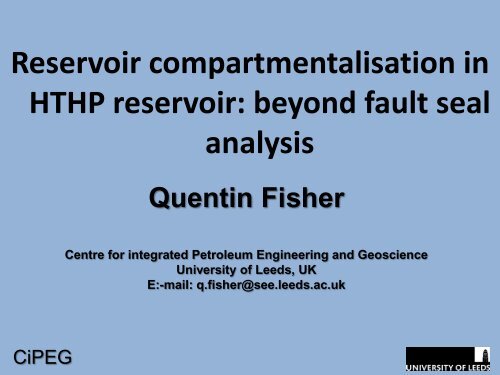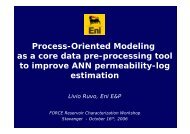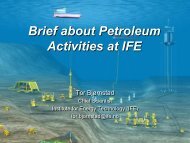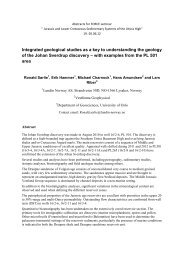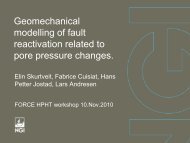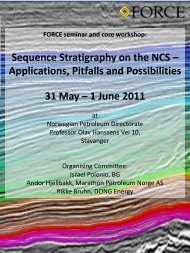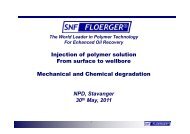beyond fault seal analysis - Force
beyond fault seal analysis - Force
beyond fault seal analysis - Force
You also want an ePaper? Increase the reach of your titles
YUMPU automatically turns print PDFs into web optimized ePapers that Google loves.
Reservoir compartmentalisation inHTHP reservoir: <strong>beyond</strong> <strong>fault</strong> <strong>seal</strong><strong>analysis</strong>Quentin FisherCentre for integrated Petroleum Engineering and GeoscienceUniversity of Leeds, UKE:-mail: q.fisher@see.leeds.ac.ukCiPEG
Outline• Impact of <strong>fault</strong>s on petroleum production• Incorporating of <strong>fault</strong> properties intoproduction simulation models• Examples of successful and unsuccessful<strong>fault</strong> <strong>seal</strong> analyses• Other causes of reservoircompartmentalisation• ConclusionsCiPEG
Impact of <strong>fault</strong>s on gas productionCiPEG(From van der Molen et al., 2003)
Fault Seal Types in SiliciclasticsJuxtaposition <strong>seal</strong>(by far the mostcommon type ofbarrier toproduction)CiPEGFault rock <strong>seal</strong>(<strong>fault</strong> <strong>seal</strong> sensustricto)- This appears to be thecase for Rotliegendexample
CiPEGFault rock <strong>seal</strong>s
CiPEGCalculation of transmissibilitymultipliersjfjffifiijktLktktLTrans22TM =jjiiijkLkLTrans2
Extensive databases on <strong>fault</strong>properties are now availableRotliegendBrent 3500 mBrent 2500 mCiPEG
Standard <strong>fault</strong> <strong>seal</strong> <strong>analysis</strong> workflowMap <strong>fault</strong>sEstimate <strong>fault</strong>rock propertiesSimulationmodelCiPEGCalculate <strong>fault</strong>transmissibility multiplierEstimate claycontent of <strong>fault</strong>
Simulation model using singlephase<strong>fault</strong> permeabilitiesvan der Molen et al., (2003)CiPEG
BHP (psi)History match from HTHP reservoir4000350030002500200015001000500No TMTM = 0.1TM = 0.01BHP00 50 100 150 200 250Time since start of production (days)CiPEGFault TMs altered on a trial and error basis until a historymatch is achieved
Fault rock permeability needed forhistory matchRotliegendJurassicCiPEGFault TMs required to achieve history match are oftenequivalent to permeabilities that are far lower than aremeasured
So why are <strong>fault</strong> permeabilitiesneeded for history matches often farlower than measured in core?CiPEG
Relative permeability of <strong>fault</strong>s321CiPEG
Lossiemouth Fault: Hopeman sandstoneHostFaultCiPEG
Capillary pressure (psi)Gas relative permeability – Hopeman <strong>fault</strong>600.00500.00400.00300.00200.00100.00CiPEGAl-Hinai et al, 20080.000.00 0.20 0.40 0.60 0.80 1.00Water saturation
Fault-related barriers to gasproductionCiPEG
CiPEGMiri cataclasite
Oil-water relative permeability – Miricataclasite/pffrCiPEG
Variation in clay content between differentinterpretations of log dataSponsor ASponsor BSponsor CSponsor DCiPEGFrom Fisher et al. 2003
Stress sensitivity of <strong>fault</strong> rockpropertiesCiPEG
Permeability (mD)Stress dependence of permeability andPermeability ratioKrgrelative permeabilityDry Mam Tor samplesStress dependence of relative permeability duringloading0.00350.003100.00250.0020.00150.001K1D1A1110.1Sw = 44.4%Sw = 40.5%Sw = 66%0.000500 500 1000 1500 2000Effective stress (psi)0.010 500 1000 1500 2000 2500Effective stress (psi)1614121086Partially saturatedDry420900 1100 1300 1500Difference in effective stress (mD)
Stress dependence of absolutepermeabilityFrom Cluff et al., (2009) Tight Gas SPE Forum• Stress dependence ofabsolute permeability oftight gas sands• No stress dependenceabove 10 mD• Suggests publisheddatabases of permeabilityof low permeability <strong>fault</strong>rocks should be treatedwith caution• Doesn’t help explainMiddle Jurassic historymatches
Stress dependence of Hg injection data• Stress dependence ofabsolute permeability of tightgas sands• No stress dependence above1 mD• Suggests publisheddatabases of Hg-injectiondata from low permeability<strong>fault</strong> rocks should be treatedwith caution• Doesn’t help explain MiddleJurassic history matchesFrom Cluff et al., (2009) Tight Gas SPE Forum
So why are such low <strong>fault</strong>permeabilities needed to historymatch some reservoir models?It’s not the <strong>fault</strong>s <strong>fault</strong>• Other possibilities include:-– Lack of sediment connectivity– Misrepresentation of three phase flow properties insimulation models– Overestimation of sediment permeabilityCiPEG
Reservoir quality in HTHP reservoirs• Rapid decrease inpermeability below12000’ due to quartzcementation and illiteprecipitation etc.• Larger uncertainties incore <strong>analysis</strong> due tostress dependency,failure to reach capillaryequilibrium, damage ofillite etc.CiPEG(from Giles et al. 1992)
Diagenetic compartmentalisationCiPEG1 mD difference in thepermeability of thereservoir can have thesame impact as a partially<strong>seal</strong>ing <strong>fault</strong>
CiPEGConclusions• To gain history match of many HTHP reservoirs far lower <strong>fault</strong>transmissibility multipliers are used than can be justified based onpublished <strong>fault</strong> rock permeability data• Taking into account problems with existing databases on <strong>fault</strong>rock properties does not provide good explanation for why suchlow TM values are needed for history match• Overestimation of sediment connectivity or failure to properlymodel 3-phase flow may be an issue• Diagenetic alteration maybe responsible for poor communicationbetween injectors and producers– Potentially reservoir permeability is slightly overestimated– Transition zone forms a permeability jail: consistent with lackof aquifer support in many HTHP reservoirs
Acknowledgements• BG, BP, Chervron, ExxonMobil, Petrobras, Total, Shell, Statoil forsponsoring research• Roxar for providing Tempest TM license• Schlumberger for providing Eclipse TM licenseCiPEG


